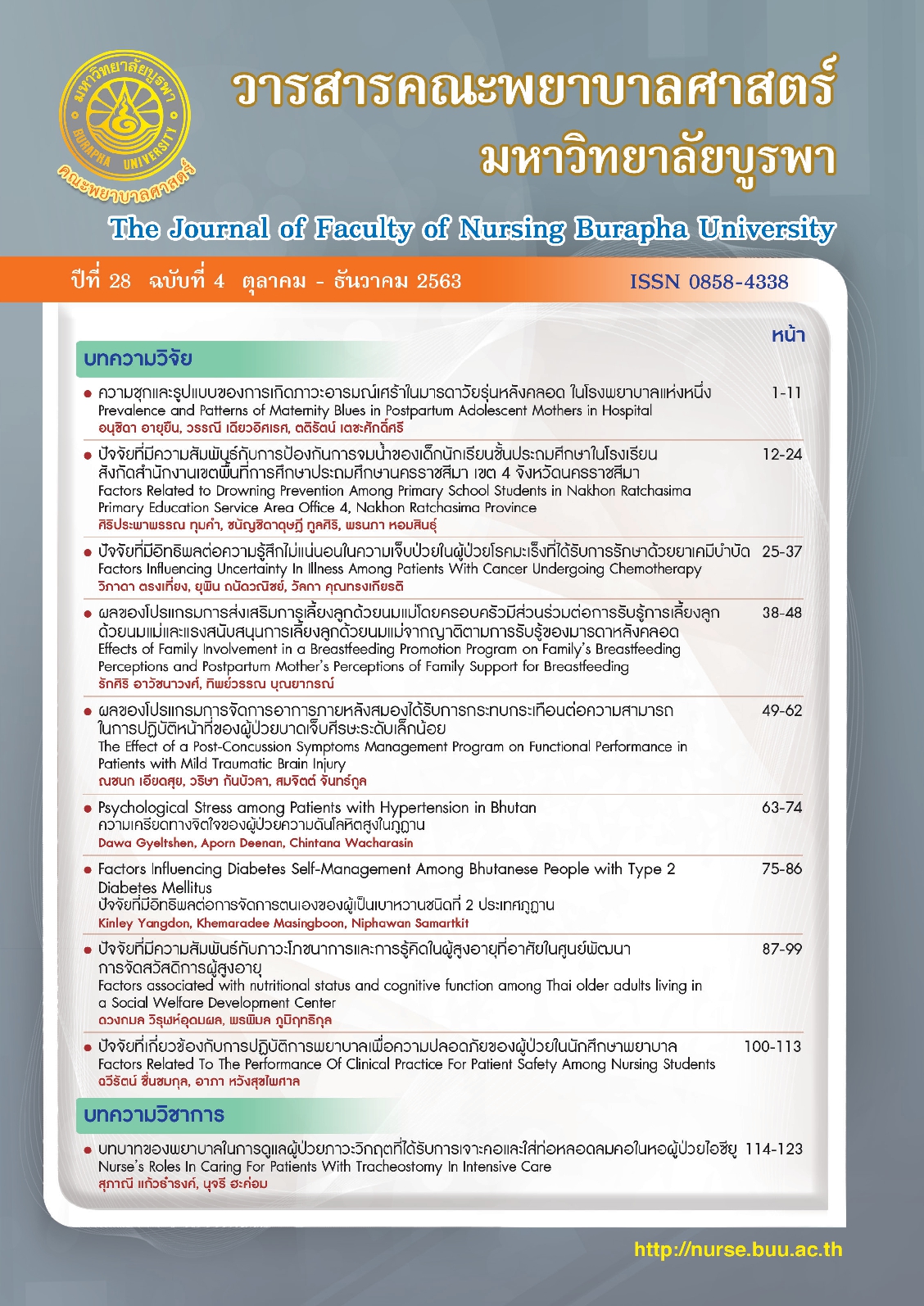ปัจจัยที่เกี่ยวข้องกับการปฏิบัติการพยาบาลเพื่อความปลอดภัยของผู้ป่วยในนักศึกษาพยาบาล
คำสำคัญ:
การปฏิบัติการพยาบาล, ความปลอดภัยของผู้ป่วย, นักศึกษาพยาบาลบทคัดย่อ
การวิจัยเชิงบรรยายนี้มีวัตถุประสงค์เพื่อศึกษาปัจจัยที่เกี่ยวข้องกับการปฏิบัติการพยาบาล เพื่อความปลอดภัยของผู้ป่วยในนักศึกษาพยาบาล กลุ่มตัวอย่าง คือ นักศึกษาพยาบาลชั้นปีที่ 3 และชั้นปีที่ 4 โดยวิธีการสุ่มอย่างง่าย จำนวน 113 คน เครื่องมือที่ใช้ในการวิจัยประกอบด้วย แบบสอบถามข้อมูลส่วนบุคคล แบบประเมินการรับรู้สมรรถนะของตนเองด้านการปฏิบัติการพยาบาลเพื่อความปลอดภัยของผู้ป่วย แบบประเมินทัศนคติต่อความปลอดภัยของผู้ป่วย แบบประเมินการปฏิบัติการพยาบาลเพื่อความปลอดภัยของผู้ป่วย วิเคราะห์ข้อมูลโดยใช้สถิติบรรยาย การทดสอบค่าที การวิเคราะห์ความแปรปรวนสองทาง และการวิเคราะห์ถดถอยพหุคูณ
ผลการศึกษาพบว่า ปัจจัยด้านผลสัมฤทธิ์ทางการเรียน ชั้นปีที่กำลังศึกษา ประสบการณ์การปฏิบัติการพยาบาล การรับรู้สมรรถนะตนเองด้านการปฏิบัติการพยาบาลเพื่อความปลอดภัยของผู้ป่วย และทัศนคติต่อความปลอดภัยของผู้ป่วยสามารถร่วมทำนายการปฏิบัติการพยาบาลเพื่อความปลอดภัยของผู้ป่วยได้อย่างมีนัยสำคัญทางสถิติที่ .05 ร้อยละ 20.60 โดยปัจจัยด้านการรับรู้สมรรถนะตนเองด้านการปฏิบัติการพยาบาลเพื่อความปลอดภัยของผู้ป่วย ระดับชั้นปี และทัศนคติต่อความปลอดภัยของผู้ป่วยเป็นปัจจัยสำคัญที่ทำนายการปฏิบัติการพยาบาลเพื่อความปลอดภัยของผู้ป่วยได้ (b =.318, p<.01, b = -.216, p<.01, b = .188, p<.05 ตามลำดับ) นักศึกษาพยาบาลที่มีผลสัมฤทธิ์ทางการเรียนต่างกันมีค่าเฉลี่ยคะแนนของการปฏิบัติการพยาบาลเพื่อความปลอดภัยของผู้ป่วยต่างกันอย่างมีนัยสำคัญทางสถิติที่ระดับ .05 นักศึกษาพยาบาลชั้นปีที่ 3 มีค่าเฉลี่ยคะแนนของการปฏิบัติการพยาบาลเพื่อความปลอดภัยของผู้ป่วยสูงกว่าชั้นปีที่ 4 อย่างมีนัยสำคัญทางสถิติที่ระดับ .05 จากการศึกษานี้สามารถใช้เป็นแนวทางในการส่งเสริมให้นักศึกษาพยาบาลมีการปฏิบัติการพยาบาลเพื่อความปลอดภัยให้เพิ่มมากขึ้น โดยการเสริมสร้างการรับรู้สมรรถนะของตนเองด้านการปฏิบัติการพยาบาลเพื่อความปลอดภัยของผู้ป่วย และทัศนคติต่อความปลอดภัยของผู้ป่วยให้กับนักศึกษาพยาบาล
เอกสารอ้างอิง
towards patient safety among a group of undergraduate medical students in saudiarabia. International Journal of Health Sciences, Qassim University, 5(1), 59-67.
Bandura A. (1997). Self-efficacy: The exercise of control. New York: W. H. Freeman.
Cohen, J. A. (1992). Power primer. Psychological Bulletin, 112(1), 155–159.
Debourgh, G. A., & Priton, S. K. (2012), Patient safety manifesto: a professional imperative for
prelicensure nursing education. Journal of Professional Nursing, 28(2), 110-118.
Doi: 10.1016/j.profnurs.2011.05.001.
Dickel, E. A., Villasecas, V. X., & Fluxá, P. J. (2020). Characterization of adverse events occurring
during nursing clinical rotations: A descriptive study. Nurse Education Today, 84(2020), 104224. Doi: 10.1016/j.nedt.2019.104224.
García-Gámez, M., Morales-Asencio, J., M., García-Mayor, S., Kaknani-Uttumchandani, S.,
Marti-Garcia, C., Lopez-Leiva, I., … Iglesias-Parra, S. R. (2019). A scoping review of safety
management during clinical placements of undergraduate nursing students.
Nurs Outlook, 67, 765-775. Doi: 10.1016/j.outlook.2019.06.003.
García-Gámez, M., Morales-Asencio, J., M., García-Mayor, S., Kaknani-Uttumchandani, S.,
Martí-García, C., Lopez-Leiva, I., … Iglesias-Parra, S. R. (2020). Adverse events
encountered during clinical placements by undergraduate nursing students in Spain, Nurse Education Today, 91, 104480. Doi: 10.1016/j.nedt.2020.104480.
Grove, S. K., Burns, N., & Gray, J. R. (2013). The practice of nursing research: appraisal, synthesis,
and generation of evidence. St. Louis, Mo. Elsevie.
Jha, A. K., Larizgoitia, I., Audera-Lopez, C., Prasopa-Plaizier, N., Waters, H., & Bates, D. W. (2013).
The global burden of unsafe medical care: Analytic modelling of observational studies. BMJ Quality and Safety, 22(10), 809–815. http://dx.doi.org/10.1136/bmjqs-2012-001748
Kong, L., Zhu, W., He, S., Chen, S., Yang, L., & Peng, X. (2019). Attitudes towards patient safety
culture among postgraduate nursing students in China: A cross-sectional study. Nurse
Education in Practice, 38, 1-6. Doi: 10.1016/j.nepr.2019.05.014.
Lewallen, L. P. & DeBrew, J. K. (2012). Successful and unsuccessful clinical nursing students.
Journal of nursing education, 51(7), 389-395. Doi: 10.3928/01484834-20120427-01.
Masoudi Alavi, N. (2014). Self-efficacy in nursing students. Nursing and Midwifery Studies, 3(4),
e25881. Doi:10.17795/nmsjournal25881.
Mitchell, R. J., Williamson, A., & Molesworth, B. (2016). Application of a human factor
classification framework for patient safety to identify precursor and contributing factors to adverse clinical in hospital. Applied ergonomics, 52, 185–195.
Doi: 10.1016/j.apergo.2015.07.018.
Nabilou, B., Feizi, A., & Seyedin, H. (2015). Patient safety in medical education: students’
perceptions, knowledge and attitudes. Plos one. 1-8.
Doi: 10.1371/journal.pone.0135610.
Ozer, S., Sarsilmaz Kankaya, H., Aktas Toptas, H., & Aykar, F. S. (2019). Attitudes toward patient
safety and tendencies to medical error among turkish cardiology and cardiovascular
surgery nurses. Journal of patient safety, 15(1), 1-6. Doi: 10.1097/PTS.0000000000000202.
Polit, D. F. & Beck, C. T. (2004). Nursing research: Principle and method (7thEd). Philadelphia:
Lippincott Williams & Wikins.
Raymond, J., Medves, J., & Godfrey, C. (2016). Perspectives on patient safety among practical
nursing students. Canadian Journal of Nursing Research, 48(2), 41–47.
Doi: 10.1177/0844562116664260.
Sngounsiritham, U. (2011). Management for Creating Safety Culture in Nursing Service.
Nursing Journal, 38(3), 168-177 [ In Thai ]
Srisatidnarakul, B. (2010). The methodology in nursing research. (5thed.). Bangkok: U & I Inter
Media Co.,Ltd. [ In Thai ]
Stevanin, S., Bressan, V., Bulfone, G., Zanini, A., Dante, A., & Palese, A., (2015). Knowledge
and competence with patient safety as perceived by nursing students: the findings of
a cross-sectional study. Nurse education today, 35(8), 926–934.
Doi: 10.1016/j.nedt.2015.04.002.
The Joint Commission on the Accreditation of Healthcare Organization Hospital. (2017).
2017 National Patient Safety Goals.
Retrieved form https://www.jointcommission.org/hap_2017_npsgs/
Usher, K., Woods, C., Brown, J., Power, T., Lea, J., Hutchison, M., …Jackson, D. (2018).
Australian nursing students’ knowledge and attitudes towards pressure injury prevention: A cross-sectional study. International Journal of
Nursing Studies, 81, 14–20. Doi: 10.1016/j.ijnurstu.2018.01.015.
Vaismoradi, M., Salsali, M., & Marck, P. (2011). Patient safety: nursing students' perspectives and
the role of nursing education to provide safe care. International nursing review,
58(4), 434-442.Doi: 10.1111/j.1466-7657.2011.00882.x.
Vanichbuncha, K. (2012). Data analysis by SPSS for Window. (20th ed.). Bangkok:
Thammasan. [ In Thai ]
World Health Organization. (2014). 10 facts on patient safety. Retrieved from
http://www.who.int/features/factfiles/patient_safety/en/.
World Health Organization. (2010). A Brief Synopsis on Patient Safety. Retrieved from
http://www.euro.who.int/__data/assets/pdf_file/0015/111507/E93833.pdf.
Zengin, N., Pinar, R., Akinci. A. C., & Yildiz, H. (2014). Psychometric properties of the self-efficacy
for clinical evaluation scale in Turkish nursing students. Journal of clinical nursing,
23(7-8), 976–84. Doi: 10.1111/jocn.12257.





